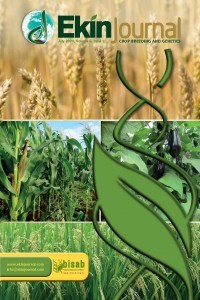Use of Heat Susceptibility Index and Heat Response Index as a Measure of Heat Tolerance in Wheat and Triticale
Use of Heat Susceptibility Index and Heat Response Index as a Measure of Heat Tolerance in Wheat and Triticale
wheat, triticale heat stress, HSI, HRI,
___
- Bhardwaj R, Sharma A, Singh H and Sharma BK, (2017). Determination of heat susceptibility indices for some quantitative traits in bread wheat (Triticum aestivum L. em. Thell.). International Journal of Pure and Applied Sciences, 5(2): 230- 239.
- Bidinger FR, Mahalakshmi V and Rao GDP, (1987). Assessment of drought resistance in Pearl millet (Pennisetum americanum L. Leeke). I. Factors affecting yields under stress. Australian Journal of Agricultural Research, 38: 37-48.
- Chowdhury SI and Wardlaw IF, (1978). The effect of temperature on kernel development in cereals. Australian Journal of Agricultural Research, 29: 205-223.
- Fischer RA and Byerlee (1991). Trends of wheat production in the warmer areas: major issues and economic considerations. Wheat for nontraditional warm areas (ed. D.A. Saunders), Maxico, D.F. CIMMYT. pp: 3-27.
- Fischer RA and Maurer R, (1978). Drought resistance in spring wheat cultivars-I: grain yield responses. Australian Journal of Agricultural Research. 29(5): 897-912.
- IPCC, (2007). Intergovernmental Panel on Climate Change fourth assessment report: Climate change. Synthesis Report, Geneva, Switzerland: World Meteorological Organization.
- Mishra SK, Tripp J, Winkelhaus S, Tschiersch B, Theres K, Nover L and Scharf KD, (2002). In the complex family of heat stress transcription factors, HsfA1 has a unique role as master regulator of thermo tolerance in tomato. Genes Development, 16: 1555-1567.
- Munjal R and Dhanda SS, (2016). Assessment of drought resistance in Indian wheat cultivars for morpho-physiological traits. Ekin Journal of Crop Breeding and Genetics, 2(1): 74-81.
- Ortiz R, Sayre KD, Goverts B, et. al., (2008). Climate change: Can wheat beat the heat. Agriculture, ecosystem and environment, 126: 46-58.
- Reynolds MP et al., (1994). Physiological and morphological traits associated with spring wheat yield under hot, irrigated conditions. Australian Journal of Plant Physiolology, 21: 717-730.
- Wahid A, Gelani S, Ashraf M and Foolad M, (2007). Heat tolerance in plants: an overview. Environmental experimental Botany, 61: 199- 223.
- Wilson A, (1876). Wheat and rye hybrids. Trans. Proceeding of Botanical Society of Edinburgh, 12: 286-288.
- ISSN: 2149-1275
- Yayın Aralığı: Yılda 2 Sayı
- Başlangıç: 2015
- Yayıncı: Bitki Islahçıları Alt Birliği
Suresh SURESH, Om Parkash BISHNOI, Rishi Kumar BEHL
Poaceae Weed Hosts of Yellow dwarf viruses (YDVs) in the Trakya Region of Turkey
Havva ILBAGI, Ahmet CITIR, Adnan KARA, Meryem UYSAL
Amel BENSELAMA, Faiza OUAREM, Sihem TELLAH, S. Mohamed OUNANE, Ghania OUNANE
Jagdeep SINGH1, Ashok Kumar CHHABRA
Combining Ability Analysis and Heterotic Effects for Cotton Fiber Quality Traits
Public Popcorn Breeding Studies of Turkey
Sekip ERDAL, Ahmet OZTURK, Mehmet PAMUKCU, Erkan OZATA, Mehmet Cavit SEZER
